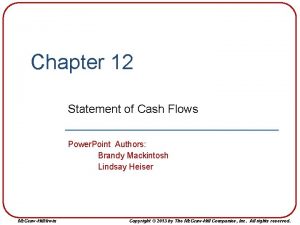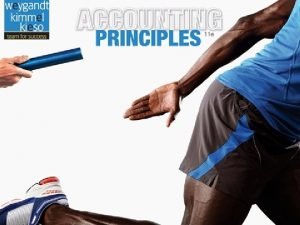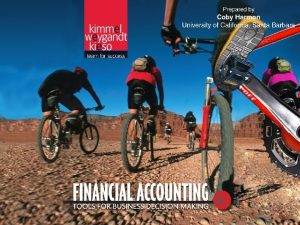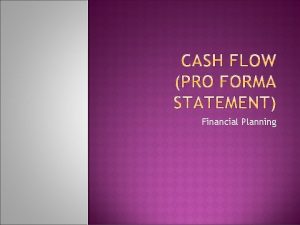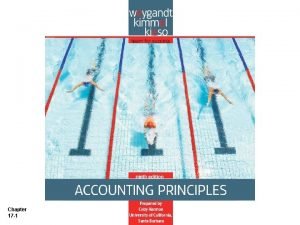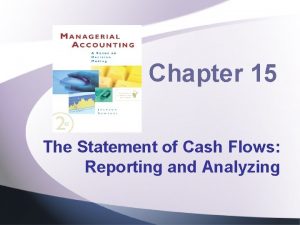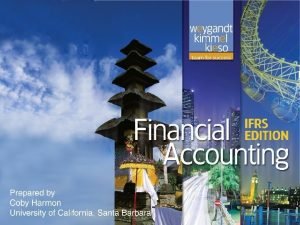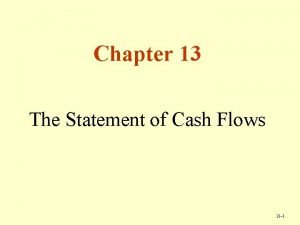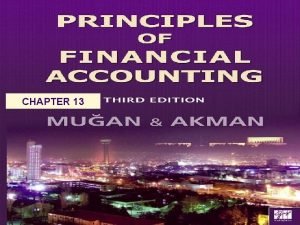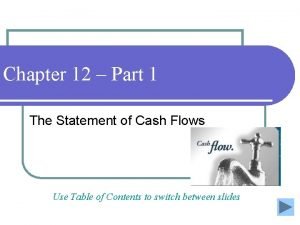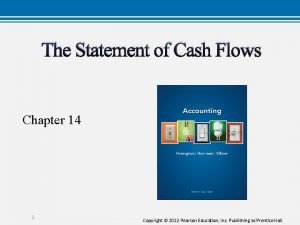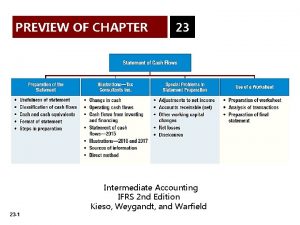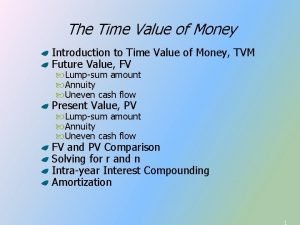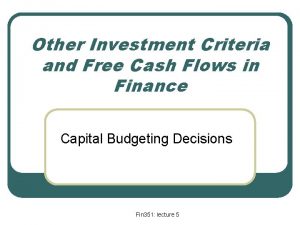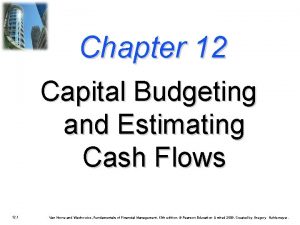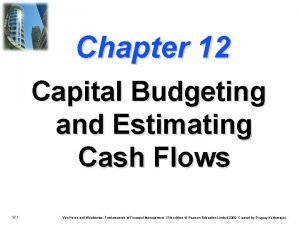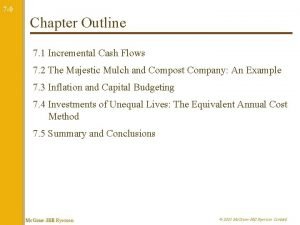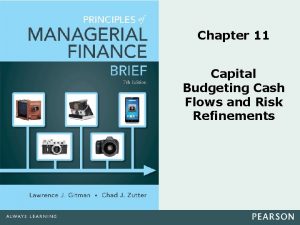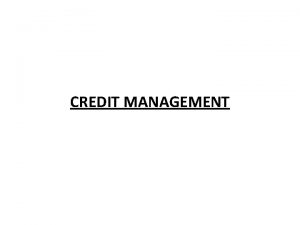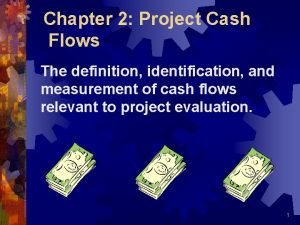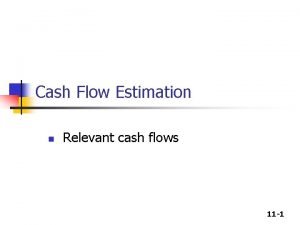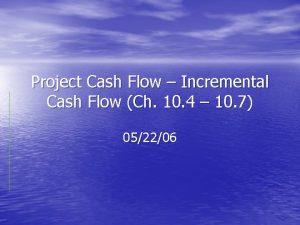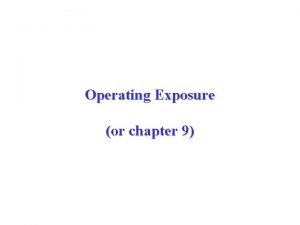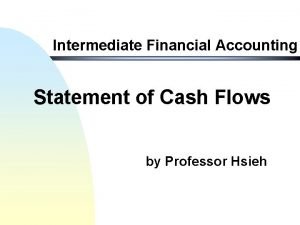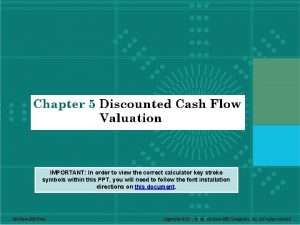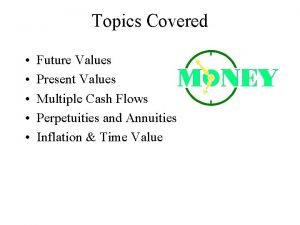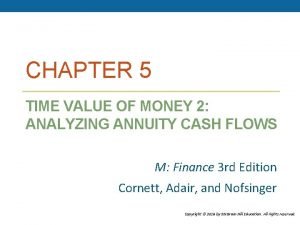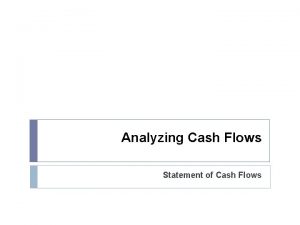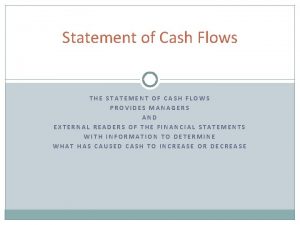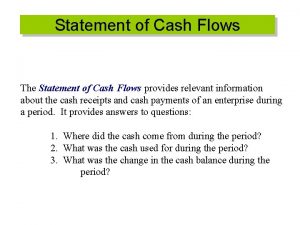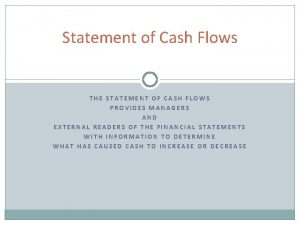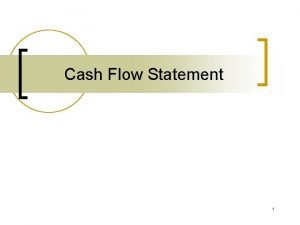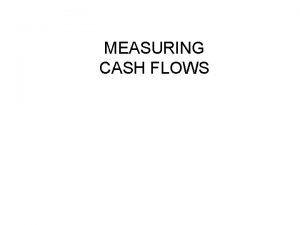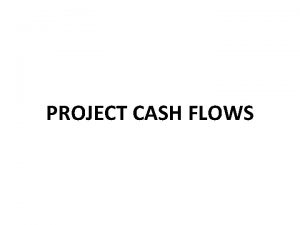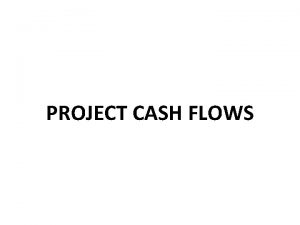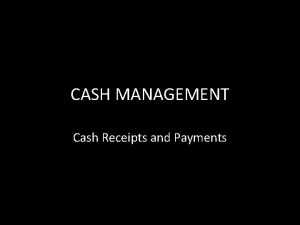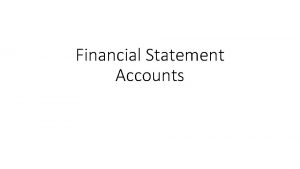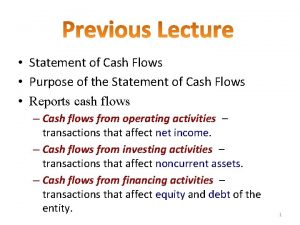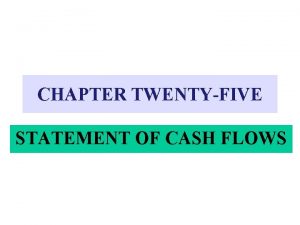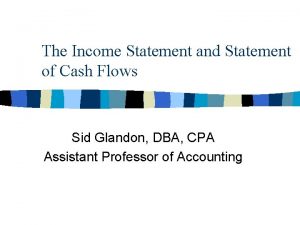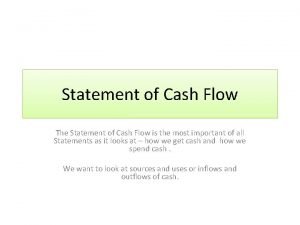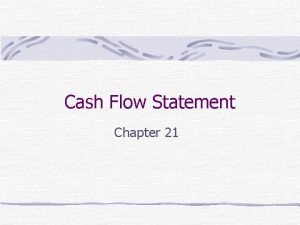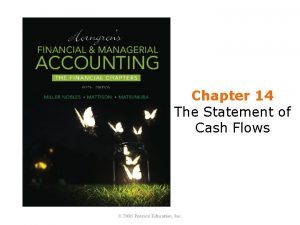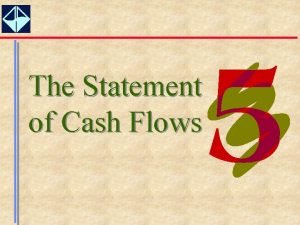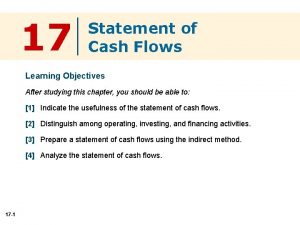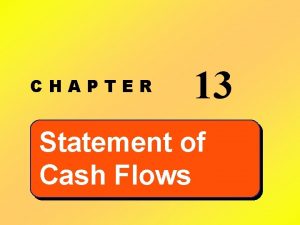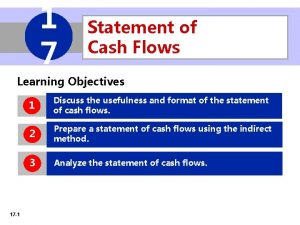17 1 17 Statement of Cash Flows Learning


































- Slides: 34

17 -1

17 Statement of Cash Flows Learning Objectives After studying this chapter, you should be able to: [1] Indicate the usefulness of the statement of cash flows. [2] Distinguish among operating, investing, and financing activities. [3] Prepare a statement of cash flows using the indirect method. [4] Analyze the statement of cash flows. 17 -2

Preview of Chapter 17 Accounting Principles Eleventh Edition Weygandt Kimmel Kieso 17 -3

Usefulness and Format Usefulness of the Statement of Cash Flows Provides information to help assess: 1. Entity’s ability to generate future cash flows. 2. Entity’s ability to pay dividends and obligations. 3. Reasons for difference between net income and net cash provided (used) by operating activities. 4. Cash investing and financing transactions during the period. 17 -4 LO 1 Indicate the usefulness of the statement of cash flows.

Usefulness and Format Classification of Cash Flows Operating Activities Investing Activities Financing Activities Income Changes in Investments and Long-Term Asset Items Changes in Long-Term Liabilities and Stockholders’ Equity Items Statement Items 17 -5 LO 2 Distinguish among operating, investing, and financing activities.

Usefulness and Format Classification of Cash Flows Illustration 17 -1 Typical receipt and payment classifications Operating activities—Income statement items Cash inflows: From sale of goods or services. From interest received and dividends received. Cash outflows: To suppliers for inventory. To employees for wages. To government for taxes. To lenders for interest. To others for expenses. 17 -6 LO 2 Distinguish among operating, investing, and financing activities.

Usefulness and Format Classification of Cash Flows Illustration 17 -1 Typical receipt and payment classifications Investing activities—Changes in investments and long-term assets Cash inflows: From sale of property, plant, and equipment. From sale of investments in debt or equity securities of other entities. From collection of principal on loans to other entities. Cash outflows: To purchase property, plant, and equipment. To purchase investments in debt or equity securities of other entities. To make loans to other entities. 17 -7 LO 2 Distinguish among operating, investing, and financing activities.

Usefulness and Format Classification of Cash Flows Illustration 17 -1 Typical receipt and payment classifications Financing activities—Changes in long-term liabilities and stockholders’ equity Cash inflows: From sale of common stock. From issuance of debt (bonds and notes). Cash outflows: To stockholders as dividends. To redeem long-term debt or reacquire capital stock (treasury stock). 17 -8 LO 2 Distinguish among operating, investing, and financing activities.

Usefulness and Format Significant Noncash Activities 1. Direct issuance of common stock to purchase assets. 2. Conversion of bonds into common stock. 3. Issuance of debt to purchase assets. 4. Exchanges of plant assets. Companies report noncash activities in either a 17 -9 u separate schedule (bottom of the statement) or u separate note to the financial statements. LO 2 Distinguish among operating, investing, and financing activities.

Usefulness and Format of the Statement of Cash Flows Order of Presentation: 1. Operating activities. 2. Investing activities. Direct Method Indirect Method 3. Financing activities. 17 -10 LO 2 Distinguish among operating, investing, and financing activities.

> DO IT! Illustration: Classify each of these transactions by type of cash flow activity. 1. Issued 100, 000 shares of $5 par value common stock for $800, 000 cash. 17 -11 Financing 2. Borrowed $200, 000, signing a 5 -year note bearing 8% interest. Financing 3. Purchased two semi-trailer trucks for $170, 000 cash. Investing 4. Paid employees $12, 000 for salaries and wages. Operating 5. Collected $20, 000 cash for services performed. Operating LO 2 Distinguish among operating, investing, and financing activities.

Usefulness and Format Preparing the Statement of Cash Flows Three Sources of Information: 1. Comparative balance sheets 2. Current income statement 3. Additional information 17 -12 LO 2 Distinguish among operating, investing, and financing activities.

Usefulness and Format Preparing the Statement of Cash Flows Three Major Steps: Illustration 17 -3 17 -13 LO 2 Distinguish among operating, investing, and financing activities.

Usefulness and Format Preparing the Statement of Cash Flows Three Major Steps: Illustration 17 -3 17 -14 LO 2 Distinguish among operating, investing, and financing activities.

Usefulness and Format Preparing the Statement of Cash Flows Three Major Steps: Illustration 17 -3 17 -15 LO 2 Distinguish among operating, investing, and financing activities.

Usefulness and Format Indirect and Direct Methods Companies favor the indirect method for two reasons: 1. Easier and less costly to prepare. 2. Focuses on differences between net income and net cash flow from operating activities. 17 -16 LO 2 Distinguish among operating, investing, and financing activities.

Preparing the Statement of Cash Flows Illustration – Indirect Method Illustration 17 -4 17 -17 LO 3 Prepare a statement of cash flows using the indirect method.

Preparing the Statement of Cash Flows Illustration 17 -4 17 -18 LO 3 Prepare a statement of cash flows using the indirect method.

Preparing the Statement of Cash Flows Illustration 17 -4 Additional information for 2014: 1. Depreciation expense was comprised of $6, 000 for building and $3, 000 for equipment. 2. The company sold equipment with a book value of $7, 000 (cost $8, 000, less accumulated depreciation $1, 000) for $4, 000 cash. 3. Issued $110, 000 of long-term bonds in direct exchange for land. 4. A building costing $120, 000 was purchased for cash. Equipment costing $25, 000 was also purchased for cash. 5. Issued common stock for $20, 000 cash. 6. The company declared and paid a $29, 000 cash dividend. 17 -19 LO 3

Preparing the Statement of Cash Flows Step 1: Operating Activities Determine net cash provided/used by operating activities by converting net income from accrual basis to cash basis. Common adjustments to Net Income (Loss): 17 -20 u Add back non-cash expenses (depreciation, amortization, or depletion expense). u Deduct gains and add losses. u Changes in noncash current assets and current liabilities. LO 3 Prepare a statement of cash flows using the indirect method.

Step 1: Operating Activities Depreciation Expense Although depreciation expense reduces net income, it does not reduce cash. The company must add it back to net income. Illustration 17 -6 17 -21 LO 3 Prepare a statement of cash flows using the indirect method.

Step 1: Operating Activities Loss on Disposal of Equipment Companies report as a source of cash in the investing activities section the actual amount of cash received from the sale. u Any loss on disposal is added to net income in the operating section. u Any gain on disposal is deducted from net income in the operating section. 17 -22 LO 3 Prepare a statement of cash flows using the indirect method.

Step 1: Operating Activities Loss on Disposal of Equipment Illustration 17 -7 17 -23 LO 3 Prepare a statement of cash flows using the indirect method.

Step 1: Operating Activities Changes to Noncash Current Asset Accounts Illustration 17 -9 17 -24 LO 3 Prepare a statement of cash flows using the indirect method.

Step 1: Operating Activities Changes to Noncash Current Asset Accounts When the Prepaid Expense balance increases, cash paid for expenses is higher than expenses reported on an accrual basis. The company deducts the decrease from net income to arrive at net cash provided by operating activities. If prepaid expenses decrease, reported expenses are higher than the expenses paid. 17 -25 LO 3 Prepare a statement of cash flows using the indirect method.

Step 1: Operating Activities Changes to Noncash Current Liability Accounts When Accounts Payable increases, the company received more in goods than it actually paid for. The increase is added to net income to determine net cash provided by operating activities. When Income Tax Payable decreases, the income tax expense reported on the income statement was less than the amount of taxes paid during the period. The decrease is subtracted from net income to determine net cash provided by operating activities. 17 -26 LO 3 Prepare a statement of cash flows using the indirect method.

Step 1: Operating Activities Summary of Conversion to Net Cash Provided by Operating Activities—Indirect Method Illustration 17 -11 17 -27 LO 3

Step 2: Investing and Financing Activities Company purchased land of $110, 000 by issuing long-term bonds. This is a significant noncash investing and financing activity that merits disclosure in a separate schedule. Land 1/1/14 Balance Issued bonds 12/31/14 Balance 20, 000 110, 000 130, 000 Bonds Payable 1/1/14 17 -28 Balance For land 20, 000 110, 000 12/31/14 Balance 130, 000 LO 3 Prepare a statement of cash flows using the indirect method.

Step 2: Investing and Financing Activities From the additional information, the company acquired an office building for $120, 000 cash. This is a cash outflow reported in the investing section. Building 1/1/14 Balance 40, 000 Office building 120, 000 12/31/14 Balance 17 -29 160, 000 LO 3 Prepare a statement of cash flows using the indirect method.

Step 2: Investing and Financing Activities Partial statement 17 -30 Illustration 17 -13 LO 3

Statement of Cash Flows Illustration 17 -13 Indirect Method 17 -31 LO 3

Step 2: Investing and Financing Activities Partial statement 17 -32 Illustration 17 -13 LO 3

Statement of Cash Flows Illustration 17 -13 Indirect Method 17 -33 LO 3

Step 3: Net Change in Cash Compare the net change in cash on the Statement of Cash Flows with the change in the cash account reported on the Balance Sheet to make sure the amounts agree. Illustration 17 -4 17 -34 LO 3 Prepare a statement of cash flows using the indirect method.
 Disadvantages of master budget
Disadvantages of master budget Statement of cash flows indirect method
Statement of cash flows indirect method Partial statement of cash flows
Partial statement of cash flows Statement of cash flows indirect method
Statement of cash flows indirect method Ammortisation schedule
Ammortisation schedule Prepaid expenses cash flow statement
Prepaid expenses cash flow statement The statement of cash flows reports
The statement of cash flows reports Taxes payable cash flow statement
Taxes payable cash flow statement Chapter 23 statement of cash flows
Chapter 23 statement of cash flows The statement of cash flows classifies items as
The statement of cash flows classifies items as Chapter 13 statement of cash flows
Chapter 13 statement of cash flows Chapter 13 statement of cash flows
Chapter 13 statement of cash flows The statement of cash flows helps users
The statement of cash flows helps users Destiny corporation is preparing its
Destiny corporation is preparing its Cash received from customers
Cash received from customers The statement of cash flows helps users
The statement of cash flows helps users Chapter 23 statement of cash flows
Chapter 23 statement of cash flows Pv of cash flows formula
Pv of cash flows formula Incremental cash flows
Incremental cash flows Payback method formula
Payback method formula Incremental cash flow
Incremental cash flow Incremental cash flows
Incremental cash flows Incremental cash flow
Incremental cash flow Iatcf
Iatcf Change in net working capital
Change in net working capital Cash flow in credit management
Cash flow in credit management Relevant cash flows definition
Relevant cash flows definition Relevant cash flow
Relevant cash flow Incremental cash flow analysis
Incremental cash flow analysis Matching currency cash flows
Matching currency cash flows Intermediate cash flows
Intermediate cash flows Ear formula
Ear formula Future value of multiple cash flows example
Future value of multiple cash flows example Future value of multiple cash flows example
Future value of multiple cash flows example Cash to cash cycle time
Cash to cash cycle time

